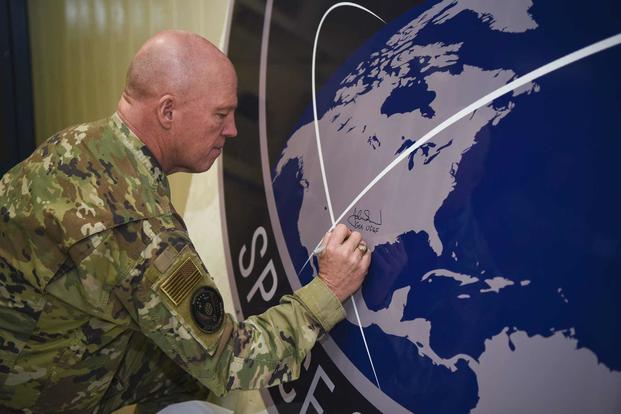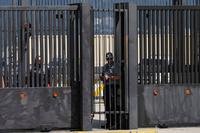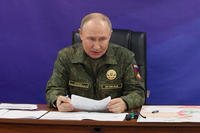U.S. Space Force, signed into law as the military's newest service just last December, has a lot to sort out, including uniforms, an official rank structure … and what to call its members.
The Pentagon is crowdsourcing ideas from individuals already assigned to the fledgling service with a very simple question: What would you like to be called?
Speaking to reporters at the Pentagon, Vice Commander of the U.S. Space Force Lt. Gen. David Thompson said that, while the process to decide on a nomenclature is still in the works, a "couple of really strong options" are on the table.
"[There are] some pretty strong opinions," he said. "But what we'd like to do is ensure we've thought as broadly as we can and have gotten the opinions of the people who matter, and those are people like ... the young folks ... and consider it as best we can before we land on a name."
Related: Great-Grandson of Tuskegee Airman Wants to Join Space Force
Thompson's comments come as an internal Space Force email has circulated on the popular, but unaffiliated Air Force Facebook page Amn/Nco/Snco asking its members to submit name ideas. A defense official confirmed the authenticity of the email to Military.com.
"What should the enlisted E1-E9 ranks in the Space Force be called? Must be gender neutral," says one bullet point in the email, per the Facebook post.
"What should the collective group of members serving in the Space Force be called? Some names floating around already are Guardians, Sentinels, and Vanguards. Feel free to create a brand new word for those who are linguistically inclined," says another.
"We are currently in the research phase to explore options for the many characteristics of culture that will define the U.S. Space Force," said Maj. Will Russell, a Space Force spokesman.
"We are following a deliberate process to ensure the name of our Space Force professionals accurately represents the excellence and heritage of the men and women of the U.S. Space Force. We will send out more details to the military space community through official channels to solicit feedback," Russell added.
The Air Force has previously used the official "Air Force Ideas" webpage, a common access card-enabled database that airmen are encouraged to use if they want to submit new concepts or solutions at the squadron level.
But Thompson said the service isn't relying solely on submissions. "We're taking steps to broaden our aperture and bring … a larger set of groups" into the conversation, he said.
That includes officials from the language department at the U.S. Air Force Academy and the Defense Department's Defense Language Institute, as well as other English language centers who've also been involved in the process.
"There are a couple of really strong options," Thompson said, but did not elaborate.
Names aside, Space Force has yet to announce a rank structure or a full system of uniforms. Last month, President Donald Trump unveiled its official seal, which includes the words "Department of the Air Force," making clear that Space Force falls under the service, just as the Marine Corps falls under the Navy.
That announcement closely followed a uniform update: The service's official Twitter account posted a teaser photograph Jan. 17 appearing to show a variant of the Operational Camouflage Pattern used by the Army and Air Force. Above the left breast pocket in Navy-colored embroidery read: U.S. Space Force.
Officials are on the hook to get answers to lawmakers: Top Air Force and Space Force officials must brief lawmakers every 60 days until at least March 31, 2023, on the status of the new branch's implementation, according to the fiscal 2020 National Defense Authorization Act signed into law in December.
The Pentagon delivered its first report to Congress on Feb. 3, Thompson said.
Roughly 16,000 active-duty and civilian personnel who used to make up Air Force Space Command are now technically assigned to the Space Force, following Trump's signing of the fiscal 2020 NDAA.
Officials on Wednesday reiterated an earlier clarification on Space Force manning: An airman who is "assigned" is a "person who performs work in support of a specific mission, in this case the U.S. Space Force; a 'transferred' individual in this situation is someone who has changed their enlistment or appointment as an officer from one particular branch of the Armed Forces to another," according to a service-outlined document that coincided with the NDAA enactment.
So far, technically only one member has transferred and sworn an oath to the U.S. Space Force: Gen. John "Jay" Raymond, the first-ever chief of space operations, Thompson said.
Of the Space Force's ultimate goal of 16,000 personnel, it plans to transfer at least 6,000 people in by year's end, Thompson said. "We expect more than that 6,000," he added.
Because commissioning and enlistment are specific to each military branch and bound in part by laws and statutes, the Pentagon must coordinate with Congress to "have them provide authorization" for specific individuals to transfer over to the Space Force, Thompson said, adding that appointing members must also be tied to adequate benefits and pay systems.
"This will go over a series of months," he said.
The career fields that will likely fully transfer are those with space-specific missions: space operations, space training, space intelligence, space acquisition, space engineering, space communications and space cyber, said Maj. Gen. Clinton E. Crosier, director of the Space Force planning task force.
Soldiers, sailors and Marines who support space operations and want to be a part of Space Force may request an interservice transfer. While that adjustment is pending, there are Army and Navy personnel working on the planning team at the headquarters, Crosier said.
"We have 24 Army members and 14 Navy members embedded on the team," he said.
-- Oriana Pawlyk can be reached at oriana.pawlyk@military.com. Follow her on Twitter at @Oriana0214.
Read more: Morale Is in Trouble at Some Army Bases. Here’s What the Service Plans to Do About It












